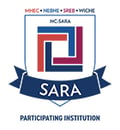 CHALLENGE
CHALLENGESymbols, Rituals, and Celebrations
Every community expresses its cherished beliefs through symbols, rituals, and celebrations. Although a relatively young institution, Neumann University has established traditions, many based on its Franciscan heritage. These symbols, rituals, and celebrations reflect Neumann’s unique mission, vision, and culture.
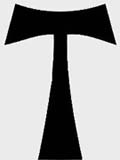 |
TAU
The meaning of the TAU, a letter of the Hebrew and Greek alphabets, is found in the ninth chapter of the prophet Ezekiel. This passage describes how persons who had turned away from sin to a life of goodness were saved from destruction. As a Franciscan symbol, the TAU, resembling the Cross, is a sign of conversion. Because of his affection and devotion to the cross of Christ, St. Francis used this sign as his personal signature. For Francis, conversion implies a turning toward God and turning to one’s brothers and sisters.
Thus the TAU becomes for us a symbol of permanent conversion, the seal of the Kingdom of God, a call to the service of others. With this sign, Francis recovers a tradition that goes back to the prophet Ezekiel. The TAU for Francis and for us is a sign of hope and a reminder of the goodness and love of God. It challenges us to live as peacemakers and to promote the healing of all creation. First year students receive a TAU cross as a sign of blessing as they engage in service.
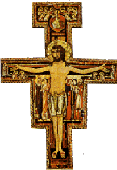 |
San Damiano Cross
This Byzantine crucifix was hanging in the abandoned San Damiano chapel outside Assisi when Francis went there to pray around the year 1206, after his release from prison following his capture in a battle with Perugia. During a time of intense prayer Francis heard the words: “Francis! Go repair my house which you see is falling to ruin.” At first Francis took the command literally and began to rebuild churches. Gradually he realized that the rebuilding to which he was called was not meant to be a literal reconstruction with stones but rather the rebuilding of human lives, church, and society. Francis also recognized in the San Damiano Cross a reminder that God became human and loved and served us, inviting us to love and serve one another.
Followers of Francis cherish this crucifix as the symbol of their mission from God to rebuild and renew anything that is falling apart — lives, relationships, institutions, communities, and the whole world! At Neumann University we reverence the San Damiano Crucifix which is placed in every room. It is appropriate that the Cross remind us to pray for guidance, using the beautiful prayer of St. Francis. After the Neumann University Baccalaureate Mass, Neumann graduates and their families may choose to receive the San Damiano cross.
Most High, glorious God, enlighten the darkness of my heart and give me true faith, certain hope, and perfect charity, sense and knowledge, Lord, that I may carry out Your holy and true command.
Greccio
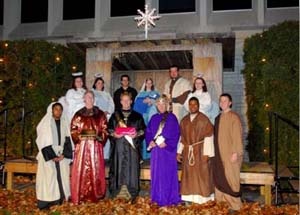 |
Francis was filled with profound awe whenever he reflected on the Incarnation, the mystery that God became a human person and lived among us. Francis loved to celebrate the feast of Christmas. Brother Thomas of Celano, the first to write a life of Saint Francis in 1229, records a special Christmas celebration at Greccio, Italy where Francis organized a Nativity scene, complete with the townsfolk and live animals. According to legend, the Christ Child appeared in Francis’s arms. (The First Life of Saint Francis by Thomas of Celano, 84–86).
Each year, Neumann University recalls the Christmas at Greccio by celebrating the Festival of Lights. Neumann students and staff members create a live Nativity scene complete with animals and a special baby recently born to a member of the Neumann community. The night is illuminated by candles and the lighting of the campus Christmas tree. A Children’s Choir from the local community shares the gift of song.
Eucharist
In addition to his devotion to the Crib (Greccio) and the Cross (TAU and San Damiano Crucifix), Francis had a great love for the Sacrament of the Eucharist. Neumann University continues the Franciscan tradition of love for the Eucharist through the celebration of daily Mass in the Sacred Heart Chapel. Celebration of the Eucharist reaches a high point every Sunday evening when Neumann students, serving as Eucharistic ministers, readers, and ministers of music and hospitality, come together. On special occasions (e.g. Mass of the Holy Spirit, Commissioning of athletes, Charter Day) the Eucharistic liturgy is celebrated in the Chapel of the Sisters of St. Francis of Philadelphia. The spirit of the Eucharist is carried forth in Neumann’s efforts to build an inclusive and diverse community where all are reverenced and all are welcome.
Blessing of the Animals
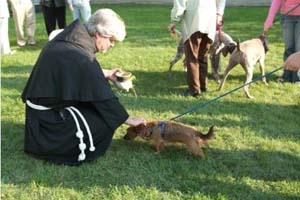 |
At Neumann University, the custom of blessing animals is conducted each year to commemorate St. Francis of Assisi’s love for creation and all of God’s creatures. St. Francis, whose feast day is celebrated on October 4, had a special relationship with animals. Early biographers recount his preaching to the birds and his taming of the ferocious wolf of Gubbio. In recent years, Francis has been adopted world wide as the patron saint of the environment. The blessing of animals may use the following words:
“Blessed are you, Lord God, maker of all living creatures. You called forth fish in the sea, birds in the air and animals on the land. You inspired St. Francis to call all of them his brothers and sisters. We ask you to bless this pet. By the power of your love, enable it to live according to your plan. May we always praise you for all your beauty in creation. Blessed are you, Lord our God, in all your creatures! Amen.”
Transitus
The remembrance of St. Francis of Assisi’s passing from this world and entrance into eternal life is celebrated each year on the evening of October 3. This prayer service is commonly referred to as “transitus” meaning “a passing over.” The Neumann University community often joins with the Sisters of Saint Francis of Philadelphia to celebrate Transitus.
Charter Day
During the month of March, the university commemorates the signing of the charter. Festivities include a Eucharistic celebration, the honoring of persons or groups significant in the life of the university, and an endowed lecture on a pertinent topic. Each year students celebrate Charter Day with special activities.

